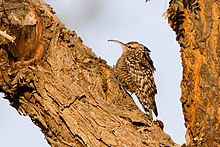
The wallcreeper is a small passerine bird found throughout the high mountains of the Palearctic from southern Europe to central China. It is the only extant member of both the genus Tichodroma and the family Tichodromidae.

The treecreepers are a family, Certhiidae, of small passerine birds, widespread in wooded regions of the Northern Hemisphere and sub-Saharan Africa. The family contains eleven species in two genera, Certhia and Salpornis. Their plumage is dull-coloured, and as their name implies, they climb over the surface of trees in search of food.

The Eurasian treecreeper or common treecreeper is a small passerine bird also known in the British Isles, where it is the only living member of its genus, simply as treecreeper. It is similar to other treecreepers, and has a curved bill, patterned brown upperparts, whitish underparts, and long stiff tail feathers which help it creep up tree trunks. It can be most easily distinguished from the similar short-toed treecreeper, which shares much of its European range, by its different song.
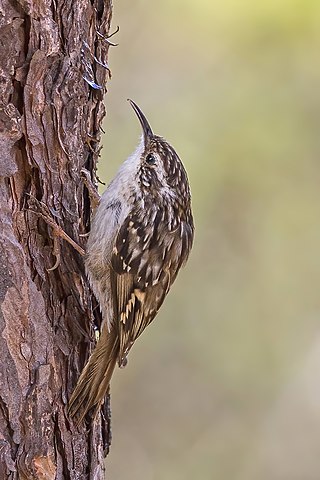
The short-toed treecreeper is a small passerine bird found in woodlands through much of the warmer regions of Europe and into north Africa. It has a generally more southerly distribution than the other European treecreeper species, the common treecreeper, with which it is easily confused where they both occur. The short-toed treecreeper tends to prefer deciduous trees and lower altitudes than its relative in these overlap areas. Although mainly sedentary, vagrants have occurred outside the breeding range.
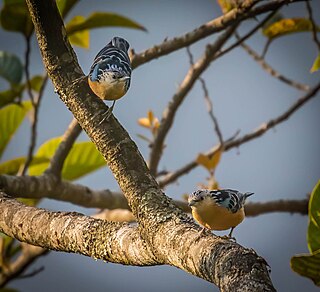
The beautiful nuthatch is a bird species in the family Sittidae, collectively known as nuthatches. It is a large nuthatch, measuring 16.5 cm (6.5 in) in length, that is not sexually dimorphic. Its coloration and markings are dramatic, the upper parts being black and azure, streaked with white and pale blue on the head and lined with the same colors on the wing feathers. The underparts are orange, and the eyebrow and throat are ochre. An irregular, dark eyestripe highlights its eye. S. formosa's ecology is not fully described, but it is known to feed on small insects and larvae found on the trunks and epiphyte-covered branches of trees in its range. Reproduction takes place from April to May; the nest is placed in the hole of an oak, rhododendron, or other large tree. The nest is made of plant material and fur in which the bird typically lays four to six eggs.

The brown creeper, also known as the American treecreeper, is a small songbird, the only North American member of the treecreeper family Certhiidae.

Certhia is the genus of birds containing the typical treecreepers, which together with the African and Indian spotted creepers make up the family Certhiidae.

Salpornis is a genus of bird which is usually included in the family Certhiidae. The genus has in the past been included with the nuthatches in the family Sittidae or placed in a family of its own, the Salpornithidae. Molecular phylogenetic analyses show them to be definitely within the Certhioidea but still leaves some uncertainty about their placement in relation to the genera Sitta, Tichodroma and Certhia. While they appear similar to the treecreepers (Certhia), they do not use their tails to support them while climbing and some molecular evidence shows them to be closer to the nuthatches (Sitta) while another study suggests a closer relation to the wallcreeper Tichodroma muraria. The generic name is derived from the Greek salpinktes for wren and ornis for bird.

The Sichuan treecreeper is a rare species of bird in the treecreeper family, Certhiidae.

The bar-tailed treecreeper, or the Himalayan treecreeper is a species of bird in the family Certhiidae. It is found primarily in the northern parts of the Indian subcontinent, particularly in the Himalayas, as well as in adjoining regions. It is found in Afghanistan, India, Iran, Kazakhstan, Myanmar, Nepal, Tibet, Russia, Tajikistan, Turkmenistan, and Uzbekistan. Its natural habitats are boreal forests and temperate forests.

The blue nuthatch is a bird species in the nuthatch family Sittidae. It is a medium-sized nuthatch, measuring 13.5 cm (5.3 in) in length. The species, which shows slight sexual dimorphism, has dramatic coloration unlike any other member of its genus. Its head is black or blackish-blue dark blue upperparts close to purple with azure feathers. The wings are edged with black. The throat and chest are white or a washed buff color, contrasting with the upperparts and the belly of a very dark blue; the covert feathers are generally clear, blue-gray or purplish.
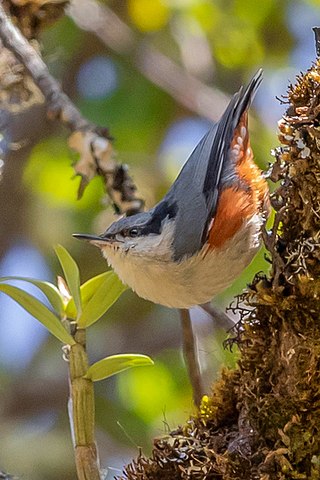
The chestnut-vented nuthatch is a species of bird in the nuthatch family Sittidae. It is a medium-sized nuthatch, measuring 12.5–14 cm (4.9–5.5 in) in length. The upperparts are a solid gray blue, with a markedly black loral stripe. The underparts are uniform gray to buff from the throat to belly, with brick red on the flanks. The undertail is white with a rufous border. The chestnut-vented nuthatch utters different kinds of calls, which can sometimes sound like a troglodyte alarm, and its song is a monotonous, stereotypical crackle, typically chichichichi. Its ecology is poorly known, but it probably feeds on small arthropods and seeds, and the breeding season begins between March and May. The nest is typically located in a hole in the trunk of a tree, and the clutch has two to five eggs.

The Yunnan nuthatch is a bird species in the nuthatch family Sittidae. It was first described by William Robert Ogilvie-Grant in 1900 based on a male holotype. It is a small nuthatch, measuring 12 centimetres (4.7 in) in length on average and weighs between 7.5 and 13 grams. The grey-blue upperparts contrast with the light, smooth, buffy lowerparts. It has a fine white eyebrow above a black eyestripe, which is distinct when the plumage is fresh, and exhibits a small degree of sexual dimorphism. A noisy bird, it produces simple, nasal sounds, sometimes in repetitive series.

Hodgson's treecreeper is a small passerine bird from the southern rim of the Himalayas. Its specific distinctness from the common treecreeper was recently validated.

Hume's treecreeper was earlier included within the brown-throated treecreeper complex and identified as a separate species on the basis of their distinctive calls. This species in the treecreeper family is found in Assam, Myanmar, Shan Mountains, Northern Thailand, Laos and the Dalat Plateau.
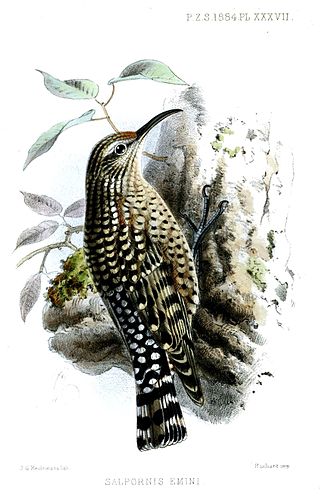
The African spotted creeper is a small passerine bird, which is a member of the subfamily Salpornithinae of the treecreeper family Certhiidae. It is found in sub-Saharan Africa in open deciduous forest and mango groves. It does not migrate other than local movements.
Spotted creeper could refer to one of two species of bird:




